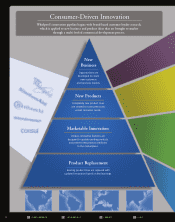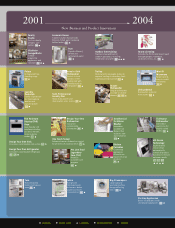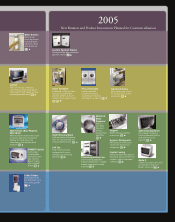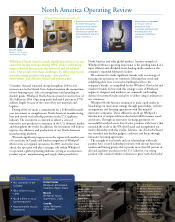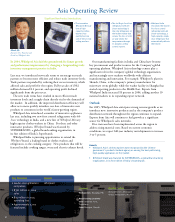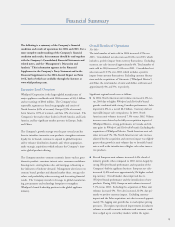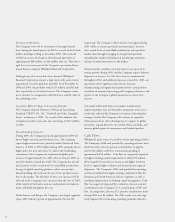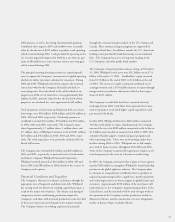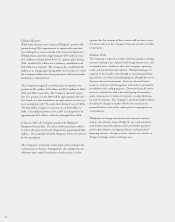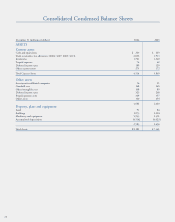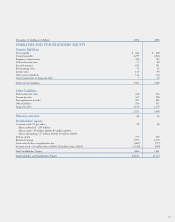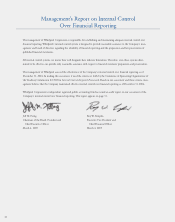Whirlpool 2004 Annual Report Download - page 24
Download and view the complete annual report
Please find page 24 of the 2004 Whirlpool annual report below. You can navigate through the pages in the report by either clicking on the pages listed below, or by using the keyword search tool below to find specific information within the annual report.
20
Strong demand for appliances in Latin America during 2004
resulted in a 14.9% increase in unit volumes versus 2003.
Economic conditions within Brazil were strong during 2004,
driven by GDP expansion, lower unemployment and positive
real wage growth. Sales increased 24% in the region during
2004 and were up approximately 20%, excluding currency,
due to market share gains, strong volume, price increases and
favorable product mix. During 2003, appliance unit volumes
in Latin America declined 2.7% versus 2002, due primarily
to the weak economic environment in the region. Overall
industry demand in Brazil declined by 11% for the year. In
2003, the region's sales increased 6.7% and increased approx-
imately 9% excluding currency impact when compared to
2002, mainly the result of price increases necessitated by
higher material costs.
During 2004, Asia's unit volumes declined 8.6% versus
2003, with a corresponding decline in net sales of 8.2%.
Excluding currency, net sales declined approximately 12%.
The decision by management to implement a trade inventory
reduction strategy in India negatively impacted 2004 volume
and sales. The strategy change will improve the speed, flexi-
bility and overall efficiency within sales and distribution
processes, and will enable the Company to launch new prod-
uct introductions more frequently and faster to the market.
During 2003, Asia's unit volumes increased 2.9% over 2002,
while net sales increased by 6.6%. Excluding currency
impact, net sales increased approximately 1%. The region
experienced a number of challenges, which negatively
impacted its performance, including significant pricing pres-
sures in China and India.
Gross Margin
The consolidated gross margin percentage in 2004 decreased 90
basis points versus 2003, primarily due to second-half material
cost increases and global pricing pressures. These costs were
somewhat mitigated by higher volume and record levels of con-
trollable productivity. The consolidated gross margin percentage
declined 60 basis points in 2003 versus 2002, due primarily to
higher U.S. pension and medical expenses coupled with reduced
Befiex credits, an increase in expense due to the decline of the
U.S. dollar and higher material costs in Latin America. The
higher expense was partially offset by productivity improvements
in North America and Europe and lower restructuring and
related expense.
Significant regional trends were as follows:
North American gross margin decreased 70 basis points com-
pared to 2003, primarily due to elevated material costs for
steel and resins. In addition, the market continued to experi-
ence competitive pricing during 2004. Margin declines were
partially offset by higher volume, productivity improvements
and some price increases. The decline in 2003 versus 2002
was due to increased pension and medical expense, partially
offset by productivity improvements.
European gross margin improved slightly in 2004 versus
2003 as productivity improvements and volume leverage
more than offset pricing pressure. In 2003, the gross margin
increased from 2002 levels due to an improvement in the
product and brand mix and productivity improvements, par-
tially offset by pricing pressures. European operations con-
tinue to realize savings from ongoing restructuring efforts in
Europe.
In 2004, Latin American gross margin declined versus 2003,
primarily due to increased material costs for steel and resins.
Higher costs were partially offset by increased volume and
price increases on both appliances and compressors and
favorable product mix. The 2003 gross margin declined ver-
sus 2002 due to significantly higher material costs and
reduced Befiex credits. The decline was partially offset by
higher appliance pricing. Price increases throughout the year
helped mitigate the margin erosion, but were not enough to
offset the increase in material costs.
Asian gross margin declined in 2004 versus 2003, primarily
due to the trade inventory reduction strategy in India and
regional pricing pressures. Asian gross margin decreased in
2003 versus 2002, due to significant pricing pressure across
the region and unfavorable product mix.



